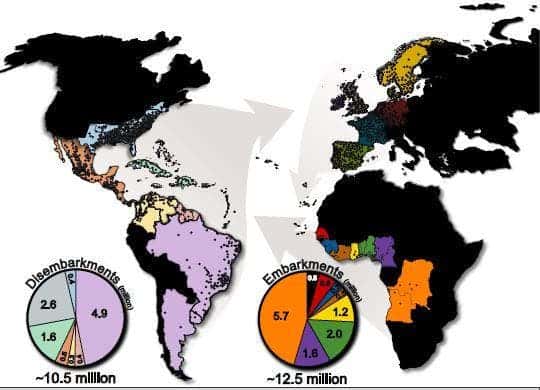
Over 10 million African natives were forcefully taken as slaves and transported to the Americas to live the rest of their days as slaves. The same fate would befall their children for hundreds of years until the end of the 19th century. This dark and shameful episode in humanity’s history is etched in the genomes of people alive today in North, Central, and South America, as well as the Caribbean. In a new study, researchers tapped into this DNA to reveal new insights about the trans-Atlantic slave trade, some of which have scaped written records.
“Our study combined the genetic data of more than 50,000 people on both sides of the Atlantic with historical records of enslaved people to create one of the most comprehensive investigations of the transatlantic slave trade,” says first author Steven Micheletti, a population geneticist at 23andMe, who employed genetic data from the Intra-American Slave Trade database. “One of the disturbing truths this research revealed was how the mistreatment of people with African ancestry shaped the current genetic landscape of African ancestry in the Americas.”
The researchers at 23andMe, a personal genomics and biotechnology company based in Sunnyvale, California, found that most African-Americans have their roots in Angola and the Democratic Republic of Congo. That was to be expected given historical records, but there were surprising patterns of migration and interbreeding that came to light when the researchers had a closer look.
One such finding was that Nigerian ancestry is over-represented in African Americans in the United States, mainly due to the “transport of slaves within the Americas, primarily from the Caribbean,” according to senior author Joanna Mountain, Senior Director of Research at 23andMe.
In contrast, the genetic flow between African Americans and Senegambians was much much lower than expected. During the height of the trans-continental slave trade, people from Senegal and Gambia disembarked in North America in great numbers.
But even this revelation wasn’t all that surprising when the researchers examined the historical records. Senegambians were mostly put to work on rice plantations in the US, which were infested with malaria and had very high mortality rates. As such, most died before they had the chance to pass on their genes.
The researchers were also able to infer the effects of policies enacted by slave-owners and local governments across the Americas. In some cases, the policies could be so different that the DNA differences became striking across many generations.
For instance, slave owners in the U.S. wanted enslaved Africans to have children with one another in order to boost the workforce. Even after slavery was abolished in the U.S. with the passing of the 13th Ammendment, those of African descent still found themselves segregated.
In contrast, slaves of African descent living in Latin America often interbred with white-skinned Europeans — in fact, the practice was very much encouraged in order to promote the “dilution” of the African ancestry. Today, the proportion of people with greater than 5% African ancestry is five times lower in Latin America than in the US, despite the fact that 70% of all African slaves disembarked in South America.
The Latin American dilution was mainly promoted between darker-skinned females and white-skinned Europeans — and this shows to this day in the DNA of their living descendants.
“Our analysis estimated about 15 African women had children for each African man in Central and South America, as well as the Latin Caribbean,” says Micheletti.
“The female bias is particularly shocking given that the majority of enslaved individuals were male,” he added, mentioning that female gene bias was also strong in North America.
Previously, another study published earlier this year by Brazilian researchers who studied the DNA of 6,267 individuals with more than 10% African ancestry from 25 populations came to similar conclusions. The study found that West Central African ancestry (from countries such as Nigeria and Ghana) is the most common in the Americas. West African ancestry (i.e. Senegal and Gambia) increases going northward while Bantu ancestry (from the south and southeast Africa) is more significant in the South of Brazil.
“The African Diaspora was so massive (>9 million people), that the genetic diversity observed in the African portions of our admixed genomes is similar to that of African populations of origin of slavery. However, admixture homogenized this diversity (and the mutations responsible for diseases) between the different populations of the African continent,” lead author Eduardo Tarazona-Santos, a researcher at the Federal University of Minas Gerais in Brazil and lead author of the study, told ZME Science.
These findings might not only provide new insights into the tragic slave-trade, but might also enable those of African descent to find their roots and come to a better understanding of what their ancestors had to go through.
“This paper conveys how the racist and dehumanizing acts endemic to the slave trade led to different patterns of African ancestry across the Americas that we can see in the DNA of people living today. We hope readers grasp not only the impact of the slave trade but also the deep contributions enslaved Africans made to the history, economy, and culture of the Americas,” says Micheletti.
The findings appeared in the American Journal of Human Genetics.






